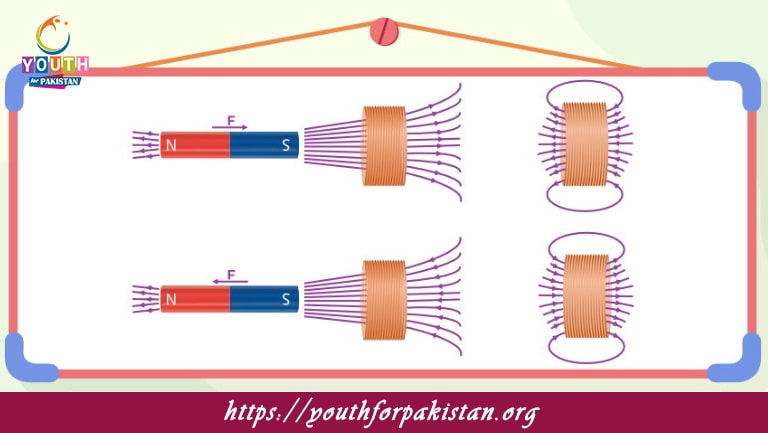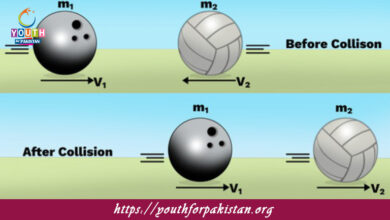Lenz’s Law MDCAT MCQs with Answers

Welcome to the Lenz’s Law MDCAT MCQs with Answers. In this post, we have shared Lenz’s Law Multiple Choice Questions and Answers for PMC MDCAT 2024. Each question in MDCAT Physics offers a chance to enhance your knowledge regarding Lenz’s Law MCQs in this MDCAT Online Test.
Lenz’s Law MDCAT MCQs Test Preparations
Lenz’s Law states that the direction of induced current will:
a) Oppose the cause of its production
b) Aid the cause of its production
c) Be random
d) Be perpendicular to the magnetic field
According to Lenz’s Law, if the magnetic flux through a coil increases, the induced current will:
a) Create a magnetic field opposing the increase
b) Create a magnetic field supporting the increase
c) Remain unaffected
d) Create an electric field
Lenz’s Law is a consequence of the law of:
a) Conservation of energy
b) Conservation of momentum
c) Conservation of charge
d) Conservation of mass
The formula that incorporates Lenz’s Law in electromagnetic induction is:
a) E = -dΦ/dt
b) E = dΦ/dt
c) E = Φ × t
d) E = I × R
If a magnet is moved towards a coil, the induced current in the coil will:
a) Repel the magnet
b) Attract the magnet
c) Have no effect on the magnet
d) Increase the magnet’s speed
Lenz’s Law is used to determine:
a) The direction of induced current
b) The magnitude of induced EMF
c) The resistance of a circuit
d) The voltage across a resistor
The negative sign in Faraday’s law (E = -dΦ/dt) represents:
a) The direction of induced EMF as per Lenz’s Law
b) The magnitude of the induced EMF
c) The energy dissipation in the circuit
d) The phase difference between voltage and current
If a current-carrying conductor is placed in a changing magnetic field, the induced current will:
a) Oppose the change in the magnetic field
b) Support the change in the magnetic field
c) Be unaffected by the magnetic field
d) Be random in direction
The purpose of Lenz’s Law in electromagnetic systems is to:
a) Conserve energy
b) Increase energy production
c) Decrease the efficiency
d) Create magnetic fields
Lenz’s Law can be observed in:
a) Induction motors
b) Generators
c) Transformers
d) All of the above
When a loop is moved towards a magnet, the induced current will be such that the magnetic field due to the induced current:
a) Opposes the approaching magnet
b) Enhances the approaching magnet
c) Is perpendicular to the magnet
d) Is zero
The induced current’s direction in a coil moving away from a magnet will:
a) Oppose the reduction in magnetic flux
b) Support the reduction in magnetic flux
c) Be perpendicular to the motion
d) Be parallel to the magnetic field lines
In a generator, Lenz’s Law causes the coil to:
a) Resist the rotation
b) Enhance the rotation
c) Have no effect on the rotation
d) Align with the magnetic field
Lenz’s Law helps in determining the:
a) Direction of induced EMF and current
b) Speed of the moving magnet
c) Strength of the magnetic field
d) Number of turns in the coil
The opposing nature of induced current as per Lenz’s Law ensures that:
a) Energy is conserved in the system
b) Current flows without resistance
c) Voltage is increased in the circuit
d) The magnetic field is amplified
Lenz’s Law is a manifestation of:
a) Newton’s Third Law
b) Newton’s First Law
c) Ohm’s Law
d) Kirchhoff’s Voltage Law
When a magnet is moved away from a coil, the direction of induced current is such that:
a) It creates a magnetic field to attract the magnet
b) It creates a magnetic field to repel the magnet
c) It creates an electric field
d) It causes the coil to heat up
Lenz’s Law can also be interpreted as:
a) A consequence of the conservation of momentum
b) A consequence of the conservation of charge
c) A consequence of the conservation of mass
d) A consequence of the conservation of energy
The effect of Lenz’s Law in a circuit is to:
a) Increase the total energy of the system
b) Decrease the total energy of the system
c) Maintain the status quo of energy in the system
d) Increase the resistance in the circuit
The negative sign in the formula E = -N(dΦ/dt) indicates:
a) The direction of the induced EMF opposes the change in flux
b) The magnitude of the induced EMF is positive
c) The flux is increasing
d) The EMF is decreasing
If the north pole of a magnet is pushed towards a loop, the loop’s induced current will produce:
a) A north pole facing the magnet
b) A south pole facing the magnet
c) No magnetic field
d) A field along the loop’s length
Lenz’s Law applies to:
a) Any change in magnetic flux
b) Only constant magnetic fields
c) Only increasing magnetic fields
d) Only decreasing magnetic fields
When a conductor moves in a magnetic field, the induced EMF and current are such that:
a) They oppose the motion of the conductor
b) They enhance the motion of the conductor
c) They are unrelated to the motion
d) They are always zero
Lenz’s Law is demonstrated in:
a) Eddy currents
b) Superconductivity
c) Capacitance
d) Dielectric breakdown
A loop of wire in a changing magnetic field will:
a) Develop a current that opposes the change in magnetic flux
b) Develop a current that enhances the change in magnetic flux
c) Be unaffected by the magnetic field
d) Only generate a current if the field increases
Lenz’s Law is consistent with the principle of:
a) Energy conservation
b) Energy dissipation
c) Power generation
d) Power loss
The magnetic field generated by the induced current in a coil due to a changing external magnetic field will:
a) Oppose the external magnetic field
b) Increase the external magnetic field
c) Decrease the external magnetic field
d) Remain constant
When a loop’s area is increased in a magnetic field, the induced current will:
a) Oppose the increase in area
b) Enhance the increase in area
c) Be independent of the area change
d) Always remain constant
In electromagnetic induction, the direction of the induced current is such that it opposes the motion of the conductor. This is due to:
a) Lenz’s Law
b) Ohm’s Law
c) Coulomb’s Law
d) Ampere’s Law
Lenz’s Law is fundamental to understanding:
a) Induction heating
b) Light emission
c) Sound generation
d) Nuclear fission
If the area of a coil in a magnetic field is decreased, the induced EMF will:
a) Oppose the decrease
b) Support the decrease
c) Not change
d) Increase the resistance
The presence of Lenz’s Law can be experimentally observed by:
a) Dropping a magnet through a metallic tube
b) Heating a coil
c) Freezing a magnet
d) Shining light on a metal
Lenz’s Law is applicable in:
a) Alternating current (AC) circuits
b) Direct current (DC) circuits
c) Both AC and DC circuits
d) Non-electrical systems only
Lenz’s Law indicates that induced EMF and current will:
a) Try to maintain the original flux
b) Try to create a new flux
c) Always be zero
d) Be maximized
Lenz’s Law is essential in the working principle of:
a) Electrical brakes
b) Mechanical brakes
c) Hydraulic brakes
d) Pneumatic brakes
When a coil is compressed in a magnetic field, the induced current will:
a) Try to expand the coil
b) Try to compress the coil further
c) Have no effect on the coil
d) Increase the temperature
The direction of the induced current in Lenz’s Law is determined by:
a) The need to oppose the change in magnetic flux
b) The applied voltage
c) The temperature
d) The coil’s color
Lenz’s Law ensures that energy:
a) Cannot be created or destroyed
b) Is created in the system
c) Is dissipated as heat
d) Is amplified
In a closed loop, the induced current from a changing magnetic field will produce a magnetic field that:
a) Opposes the initial change in flux
b) Supports the initial change in flux
c) Is perpendicular to the initial flux
d) Is parallel to the initial flux
In an electric generator, Lenz’s Law is the reason why:
a) Mechanical energy is converted into electrical energy
b) Electrical energy is converted into mechanical energy
c) Energy loss is minimized
d) Voltage remains constant
If you are interested to enhance your knowledge regarding Physics, Chemistry, Computer, and Biology please click on the link of each category, you will be redirected to dedicated website for each category.





